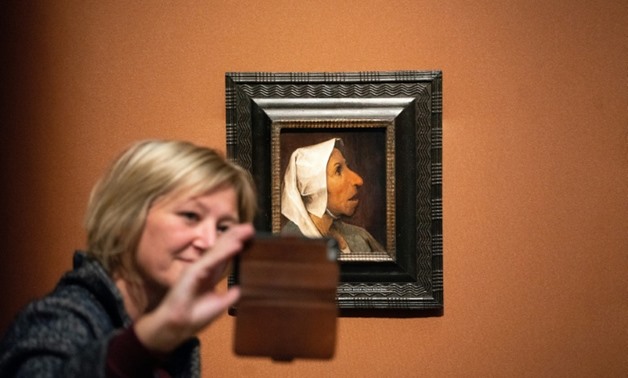
A visitor takes a selfie with the painting 'Head of a Peasant Woman' at the world's first monograph exhibition dedicated to Flemish master Pieter Bruegel the Elder in Vienna.
The world's first-ever monograph exhibition dedicated to 16th century Flemish master Pieter Bruegel the Elder opens Tuesday in Vienna, bringing together half of all of his extant works, organisers said.
Ahead of the 450th anniversary of his death next year, the Kunsthistorisches Museum (KHM) is hosting an unparalleled exhibition of 27 of his paintings and 60 drawings and prints.
And it will notably reunite for the first time two versions of Bruegel's iconic "Tower of Babel" masterpiece and four from his cycle of "Seasons".
Many of the international loans were so old and fragile that they hardly ever travelled and many of the works to go on show had never before left their hometowns.
"Everyone knows Bruegel, whether it be from reproductions on calendars or on biscuit tins. But never before have so many of his works been gathered in one place," Penot said.
Bringing together Bruegel's masterpieces into a single exhibition that has been six years in preparation was "something of a miracle", co-curator Sabine Penot told AFP.
The KHM had something of a head start, as it already owned 12 Bruegel paintings, including one of the "Tower of Babel", "Peasant Wedding", "Children's Games" and three of the "Seasons".
That was because Bruegel's works "were collected very early on by two members of the Habsburg family, Archduke Ernest, who ruled the Netherlands, and his brother, Emperor Rudolf II", said art historian Alice Hoppe-Harnoncourt.
In 2012, the KHM began an in-depth technical examination of the paintings, using X-ray and infra-red technology, that had never previously been carried out on Bruegel's works.
And from there, a number of institutions, particularly in Belgium, agreed to collaborate for this exhibition, Penot said.
- 'Cinematographic field of vision' -
The show brings together pieces from around 30 private and public collections all over the world, from Antwerp and Madrid, to New York, Paris, Prague and Rotterdam.
And among the highlights is "Adoration of the Kings in the Snow" from Winterthur, which required a special law to be able to leave Switzerland, as well as "The Port of Naples" which was recently authenticated after being restored in Rome.
Unfortunately, the Metropolitan Museum of New York decided not to loan the "Harvesters" which would have rounded off the five "Seasons" paintings known to be still in existence, said Penot.
Another co-curator, Manfred Sellink, director of the Royal Museum of Fine Arts in Antwerp, Belgium, said Bruegel's works continued to fascinate because "he succeeds in portraying astonishingly precise detail with a literally cinematographic field of vision".
Parallel to the real exhibition is an accompanying website, http://www.insidebruegel.net, which allows the user to zoom in on details in the paintings that are not easily visible to the naked eye.
Already famous during his own lifetime and the head of a long dynasty of painters, the popularity of Bruegel (1525/30-1569) has come and gone across the centuries.
"In the 18th century, most of his work had been put into storage and was only really rediscovered at the beginning of the 20th century," said Hoppe-Harnoncourt.
"Every generation has tried to unravel the mysteries of Bruegel, but none has really succeeded, since his work is so rich," said Penot.


Comments
Leave a Comment